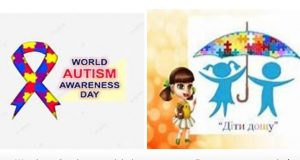

Every year on April 2, the world celebrates Autism Awareness Day, established by the UN General Assembly in 2007. Around the world, on April 2, blue is worn as a sign of support for people with autism. Blue color and puzzles are symbols of this day.
Autism — Autism Spectrum Disorder (ASD) — is a condition that occurs as a result of impaired brain development and is characterized by a congenital and comprehensive deficit in social interaction and communication. It cannot be cured, but over time it is possible to adjust and adapt a person to social life. Autistic spectrum disorders begin in childhood and persist into adolescence and adulthood.
The prevalence rate is independent of racial, ethnic, and socioeconomic differences. The disease is five times more common in boys (1 in 54) than in girls (1 in 252). Epidemiological studies conducted in Asia, Europe, and North America show an average prevalence of ASD of about 1%. Autistic spectrum disorders are considered the result of the interaction of genetic and environmental factors. The role of genetic factors in the genesis of autism is decisive. Neurodevelopmental disorders are also associated with a number of harmful factors that act during pregnancy and childbirth (teratogens, smoking, infections in the mother, taking medications during pregnancy).
Five environmental factors—mercury, cadmium, nickel, trichloroethylene, and vinyl chloride—have been identified, and increased exposure is associated with ASD. Another 3 environmental risk factors are living in urbanized regions, in areas located at higher latitudes, and in regions with high rainfall throughout the year, which is associated with insufficient solar insolation and leads to vitamin D deficiency. Among the factors that increase the risk pervasive development in the period of conception, include: the presence in the family history of cases of ASD, disorders of speech development, severe mental disorders (schizophrenia, bipolar disorder); late (over 30 years) age of the mother and/or father at the time of conception, in vitro fertilization.
The primary prevention of autism is the screening of children’s development during scheduled preventive examinations at the age of 9, 18, 24 and 36 months in order to identify persons with developmental delays (clinical protocol of medical care for a healthy child under 3 years of age, approved by the order of the Ministry of Health of Ukraine dated 20.03. 2008 No. 149). The main components of the therapy of children with ASD are early psychosocial intervention, careful and balanced use of drug therapy, the effectiveness of which has been proven, active participation of the family based on the achieved compliance, the use of any forms of intervention exclusively in outpatient settings. Early interventions reduce overall costs per ASD patient over the course of a lifetime through better social and occupational adaptation outcomes.
For the purpose of early identification of children with ASD at Odesa Regional Medical Center of Mental Health at Odesa, st. Ac. Vorobyova, 9 (clinical base of the department) operates the Early Intervention Center, where parents with children with neurodevelopmental problems can undergo appropriate screening.